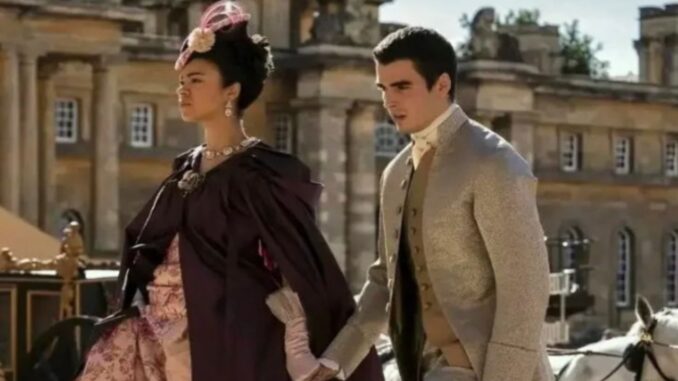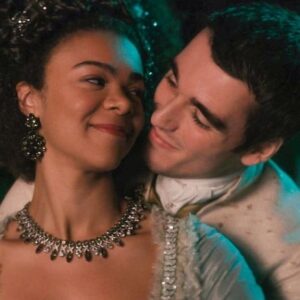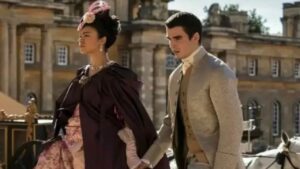
Everything to know about the real Queen Charlotte before her Bridgerton series
It’s almost time to get your hand fans out and your smelling salts ready, as we’re soon to return to the swoon-worthy world of Bridgerton. This time around, though, we’re going into the past to take a look at the lives of Queen Charlotte (played by Golda Rosheuvel in the “present” and by India Amarteifio when the character is younger), Lady Danbury, and Lady Bridgerton when they were younger.
Queen Charlotte: A Bridgerton Story, which premieres May 4 on Netflix, is sure to boast grand balls, steamy sex scenes, and plenty of gossip, as per the hallmarks of the historical-fiction juggernaut. But there’s also likely to be some very real heartbreak along the way, if the show stays true (or as true as it can while still taking creative license) to the lives of the real Queen Charlotte and King George III
“My life as Queen,” intones Rosheuvel as the older Charlotte in the teaser, “was difficult.” Here’s a hint of just what she means, with our primer to the real Queen Charlotte.
1. Say hello to Sophia Charlotte of Mecklenburg-Strelitz
Born Sophia Charlotte of Mecklenburg-Strelitz (what a mouthful) on May 19th, 1744, the woman who came to be known as Queen Charlotte was German royalty: the youngest daughter of Duke Charles Louis Frederick of Mecklenburg-Strelitz and Princess Elizabeth Albertina of Saxe-Hildburghausen.

Her hometown of Mecklenburg-Strelitz was a small northern German duchy in the Holy Roman Empire, and she was the youngest of her family. She was educated in botany and natural history, and spent much of her upbringing sewing and embroidering every day, and she was a voracious reader. Due to the remoteness of her hometown, she didn’t have much of a social life; there were certainly not as many balls or events as the Bridgerton women attended. It was all to make her the perfect bride….
2. Queen Charlotte married her husband within six hours of meeting him
Although it’s probably fair to say that as a 17-year-old girl from a noble family being offered to the king of England, she didn’t have the chance to say no. When 22-year-old King George III took the throne in 1760, his first priority (probably) was to find a wife. What followed was a methodical search, with the king’s advisors heading out to put together reports on the potential candidates on a list created by the king and others.
At the time, the teen Princess Charlotte was a good option: She was a Protestant; she was said to be sweet and compliant; and as a minor royal she wouldn’t be a political threat. How romantic. So in 1761, after a number of others had been eliminated, Charlotte was selected unseen by King George III, and the Earl of Harcourt led a party of escorts to fetch the German princess to England. The return voyage was difficult, with three storms at sea. Like every bride, Charlotte probably wanted to look her best on her wedding day; instead, she was so thin after suffering from seasickness that her heavy, diamond-encrusted wedding dress nearly fell off her.
She arrived in London on September 8th, and within six hours had married King George III at the Chapel Royal, St James’ Palace. Methodical searches and seasickness: It’s hardly the stuff of fairytales, or even of television shows, so we’ll likely get more than a little bit of artistic license when it comes to the courtship of Charlotte and George. The show definitely gives us more time between Charlotte coming to England and her marriage to the king, and a lot more tension, with a Charlotte who is perhaps not as meek in her teen years as her real-life counterpart. Less lists, more lust, if you will.3. Sophia and George had 15 children
It might not be in any guide to etiquette followed by the royal court, but the only appropriate reaction here is to wince. Less than a year after getting married, Queen Charlotte gave birth to her first child, the Prince of Wales, who would later become King George VI. In total, the royal couple had 15 children, the youngest of which was Princess Amelia, born in 1783. For those keen on math, that’s 15 children in 21 years, or one child every 1.4 years.
Despite being a one-woman baby factory—or perhaps because of it—Charlotte and George had a happy marriage, attending plays and concerts and duetting together on the harpsichord and flute. (The couple that plays music together stays together goes that not-so-well-known saying.)
Not many letters between the pair survive, or perhaps even exist given they spent so little time apart. But in one that does from 1778, nearly 17 years after their wedding, Charlotte’s affection for her husband is clear, as she writes: “You will have the benefit by Your voyages to put Spirit in every Body, to be more known by the World, and if Possible more beloved by the People in general. That must be the case, but not equal to the love of her who subscribes herself—Your very
affectionate Friend and Wife Charlotte.”
That romance is likely to be the focus of Queen Charlotte: A Bridgerton Story, although with less childbirth (although the teaser does have King George’s mother commanding Charlotte to “make as many babies as possible for my son”).
4. Queen Charlotte was the originator of the debutante ball (and she had a hand in discovering Mozart)
Blair Waldorf and the Upper East Side have a lot to thank Queen Charlotte for. In 1780, a May ball was held by King George III in honor of his wife, to raise money for a hospital, and it was widely thought to be the first notable debutante ball. It became an annual event, and each year an exclusive group of high-class young women, usually aged around 17 or 18, would be formally introduced to the monarch. Other balls and outings followed, leading to the formation of a “season” during which the elite danced, partied, and flirted.
The debutante ball is not Queen Charlotte’s only legacy; for a woman with 15 children, she somehow found the time to pursue various hobbies, including being an amateur botanist: Her interest in plants and flowers led to the South African flower, the Bird of Paradise, being named Strelitzia reginae in her honor.
She and her husband were also connoisseurs of music and especially loved German composers. Aged just eight, Mozart performed for the Queen and was invited to perform at the celebration of the fourth anniversary of the King’s accession in 1764. His Opus III was dedicated to the Queen when it was published in January 1765.

5. Yes, she was married to that King George
If you were around during the Great Hamilton Obsession of the 2010s, you’ll know of King George: He is indeed the monarch who presided over England during the American Revolution, and he did indeed suffer from mental health problems later in life, earning him the now rather unkind moniker of Mad King George.
When King George III first suffered from mental illness in 1765, it was kept from his wife. During that time, the Regency Bill of 1765 stated that if the King should become permanently unable to rule, Charlotte would become Regent. It looks like the show may shift the timeline slightly; we see a young king being led away by advisors, and Queen Charlotte’s guard Brimsley saying of the queen that “she is his wife. She must know.”
The real King George III recovered, but when he fell ill again in 1788, it caused conflict between Charlotte and her oldest son, the Prince of Wales, as he was declared regent should the king remain ill. The bill also placed the king, his court, and minor children under the guardianship of the Queen.
The couple’s great romance had a sad end; the king’s manic behaviors—his illness caused him to become violent—terrified and upset the Queen, and their relationship was never the same. As shown in Bridgerton, the couple led increasingly separate lives. Charlotte remained her husband’s guardian until her death in 1818; George died two years later in 1820.
6. Queen Charlotte may really have had Black ancestry (although it’s much disputed)
The world of TV Bridgerton, although not book Bridgerton, is famously multicultural, even though race is clumsily handled at times: A memorable scene between Lady Dancury (Adjoa Andoh) and the Duke of Hastings (Regé-Jean Page) in the first season tells us that the marriage of King George III and Queen Charlotte pretty much erased racism. As if it would be that easy. (Harry and Meghan probably have something to say about this.)
Still, the show may have taken inspiration from real life, at least when it came to ethnicity, if not to how people of color were received in British society. Historian Mario de Valdes y Cocom argues that Queen Charlotte was descended from a Black branch of the Portuguese royal family, and that her ancestry can be traced back to Africa.
However, his view is regarded with skepticism by many other historians; they say the evidence is on the thin side, and that the generational distance is so great that the suggestion doesn’t hold up.
Whether or not the real Queen Charlotte did have Black ancestry, her ethnicity is certainly important to the world of the show, and we’ve high hopes for a more sophisticated handling of, and discussion around, the racism of British society at the time. A young Lady Danbury (Arsema Thomas) tells Queen Charlotte that she needs to “be careful” because she is the “first of your kind.”
If that all sounds too deep for a show that’s spun off from a program famous for its rollicking sex scenes, never fear: We’re sure there’ll be plenty of those too.
